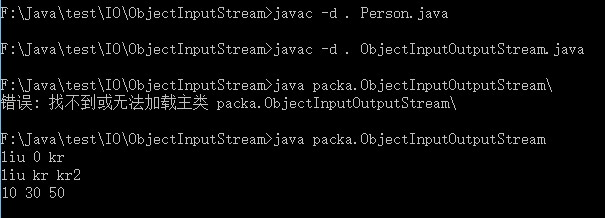使用ObjectInputStream的readObject()方法如何判断读取到多个对象的结尾
Posted LiuYanYGZ
tags:
篇首语:本文由小常识网(cha138.com)小编为大家整理,主要介绍了使用ObjectInputStream的readObject()方法如何判断读取到多个对象的结尾相关的知识,希望对你有一定的参考价值。
摘自http://blog.csdn.net/fjdingsd/article/details/46765803
使用ObjectInputStream的readObject()方法如何判断读取到多个对象的结尾
import java.io.EOFException; import java.io.FileInputStream; import java.io.IOException; import java.io.ObjectInputStream; import cn.com.mybolg.bean.Person; /* * 若文件中有若干个Object对象,你用ObjectInputStream中的readObject()去读,何时判读到结尾? * 方法之一:(常用的方法)将若干个对象(数量不定)都装入一个容器中(如:ArrayList之类), * 然后将容器这一个对象写入就行了。读取时,只要读取一个对象(即容器对象)就行了。 * * 方法之二:(若不想用容器),则由于数量不定,正是用EOFException来判断结束。 * 代码结构如下:(无论是readInt()读int,还是readObject()读对象) * try{ * while(true) { * Object o=ois.radObject(); * 处理已读出的对象o; * } * } * catch(EOFException e){ * //已从流中读完。 * } * finallly { * 流的关闭。 } */ public class ObjectInputStreamDemo { public static void main(String[] args) throws IOException, ClassNotFoundException { FileInputStream fis = new FileInputStream("F:\\\\person.object"); ObjectInputStream osi = new ObjectInputStream(fis); try { while(true) { Person p = (Person) osi.readObject(); System.out.println(p.getName()+":"+p.getAge()); } } catch(EOFException e) { } finally { osi.close(); } } }
以下是自己的试验:
往文件里存多个对象也没问题,调用writeObject()一直往里写即可,readObject()一次返回一个对象,再readObject()一次返回第二个对象,自动在每个对象后面做标记。并且同一个文件中可以依次存入不同类的对象。先存入一个Person对象,再存入一个Demo对象,再存个Haha对象都可以。按顺序读就行了。

package packa; import java.io.*; class ObjectInputOutputStream { public static void main(String[] args)throws Exception { writeObj(); readObj(); } private static void writeObj()throws Exception { ObjectOutputStream oos = new ObjectOutputStream(new FileOutputStream("person.object")); oos.writeObject(new Person("liu", 30, "kr")); oos.writeObject(new Person2("liu", "kr", "kr2")); oos.writeObject(new Person3(10, 30, 50)); oos.close(); } private static void readObj()throws Exception { ObjectInputStream ois = new ObjectInputStream(new FileInputStream("person.object")); System.out.println(ois.readObject()); System.out.println(ois.readObject()); System.out.println(ois.readObject()); ois.close(); } }
package packa; import java.io.*; class Person implements Serializable { public static final long serialVersionUID = 44L; String name; transient int age; static String country = "cn"; Person(String name, int age, String country) { this.name = name; this.age = age; this.country = country; } public String toString() { return name + " " + age + " " + country; } } class Person2 implements Serializable { public static final long serialVersionUID = 45L; String name; String country; String country2; Person2(String name, String country, String country2) { this.name = name; this.country = country; this.country2 = country2; } public String toString() { return name + " " + country + " " + country2; } } class Person3 implements Serializable { public static final long serialVersionUID = 46L; int age; int age2; int age3; Person3(int age, int age2, int age3) { this.age = age; this.age2 = age2; this.age3 = age3; } public String toString() { return age + " " + age2 + " " + age3; } }
以上是关于使用ObjectInputStream的readObject()方法如何判断读取到多个对象的结尾的主要内容,如果未能解决你的问题,请参考以下文章
java使用ObjectInputStream从文件中读取对象
objectinputstream available() 返回 0
为啥我使用 ObjectInputStream 一次只能读取 1024 个字节?